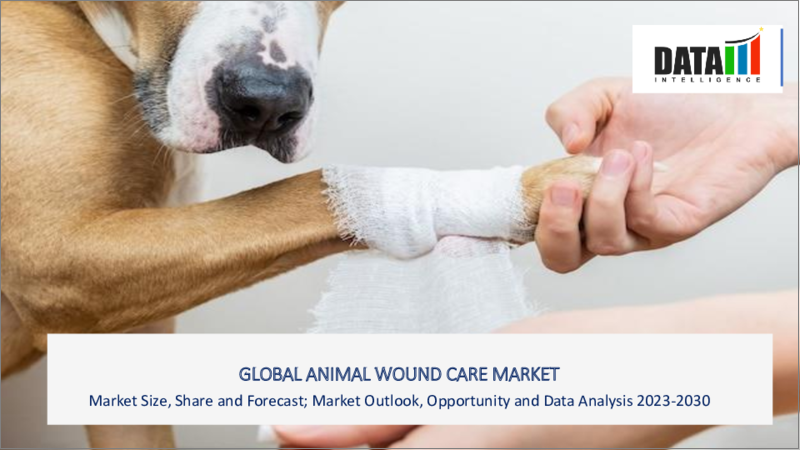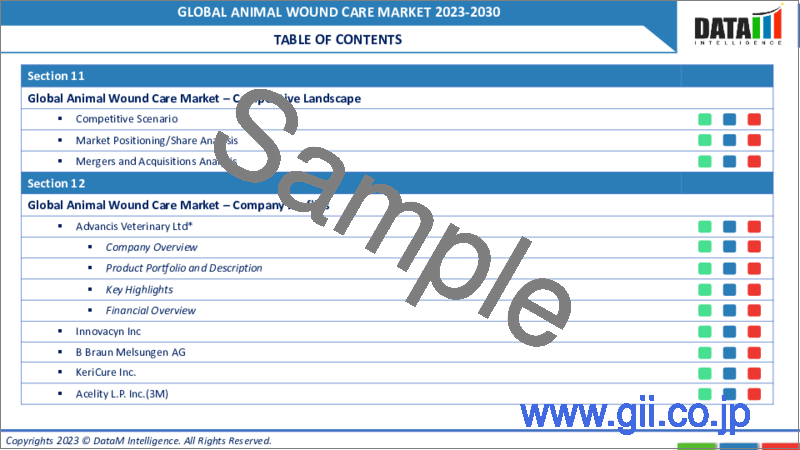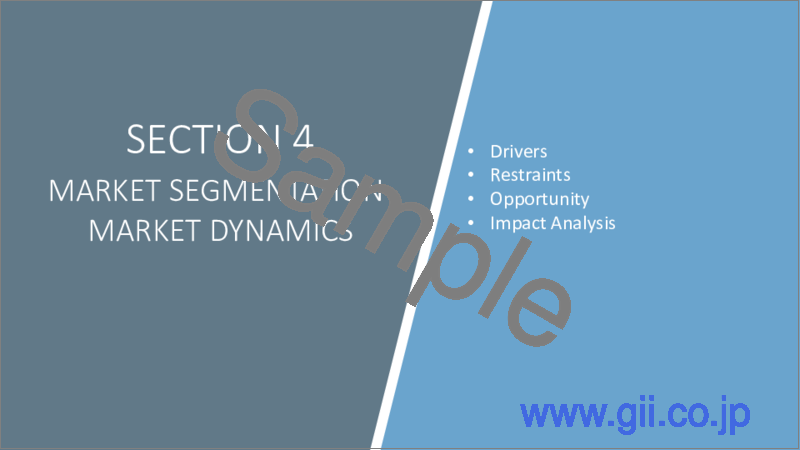|
|
市場調査レポート
商品コード
1208607
動物用創傷被覆材の世界市場-2023-2030Global Animal Wound Care Market - 2023-2030 |
||||||
|
● お客様のご希望に応じて、既存データの加工や未掲載情報(例:国別セグメント)の追加などの対応が可能です。 詳細はお問い合わせください。 |
|||||||
| 動物用創傷被覆材の世界市場-2023-2030 |
|
出版日: 2023年02月01日
発行: DataM Intelligence
ページ情報: 英文 200 Pages
納期: 約2営業日
|
- 全表示
- 概要
- 目次
市場概要
動物の創傷治療の世界市場規模は、2022年に1億8500万米ドル、2030年には6億8500万米ドルに達すると推定され、予測期間(2023~2030年)にCAGR6.3%で成長すると言われています。
動物が外傷を負ったりショックを受けたりした場合、動物が安定した時点で一般的な創傷治療が始まります。止血のための圧迫や簡単な包帯などの応急処置は、通常すぐに完了します。傷口の洗浄(ラベッジ)は、目に見える微細な物質を除去します。こうすることで、感染のリスクを減らすことができます。傷口を洗浄するために、注射器を使って傷口に溶液を吹き付けます。
創傷の洗浄は、デブリードメントとも呼ばれ、死んだ組織や異物を取り除くことで、細菌汚染や感染リスクを軽減することができます。感染症にかかった傷口からサンプルを採取し、培養することができます。細菌感染は、抗生物質で治療します。さらに、鎮痛剤を投与するのが一般的です。
市場力学
世界の動物用創傷治療市場を牽引する主な要因コンパニオンアニマルの数が増加し、獣医による処置や創傷治療の需要が同時に高まり、狂犬病、口蹄疫、ブラッククォーター(別名「黒い脚」)などのさまざまな病気の流行が増加するにつれて、市場は拡大すると思われます。
コンパニオンアニマルの増加に伴い、市場の拡大が見込まれます。
コンパニオンアニマルの総数や飼育率は世界的に上昇しています。コンパニオンアニマルを飼うことで、不整脈のリスク低減、血圧の正常化、不安感の軽減、心理的安定性の向上などのメリットがあることは、数多くの研究により実証されています。動物の健康に対する一人当たりの出費が増加しているのは、都市化の拡大が主な原因です。動物の健康にもっとお金をかけたいという飼い主の願望の増加、動物の健康問題に対する国民の意識の高まり、動物の健康のためのハイテクサービスを提供する獣医師の能力などが、現在さまざまな動物用創傷ケア製品の市場を牽引している要因となっています。
例えば、Petpedia.co 2021の犬の養子縁組の事実と統計によると、世界で最も犬や猫の人口が多いのは米国です。米国の犬の飼育数は6990万頭で、2位は中国、3位はロシアで、それぞれ2740万頭、1250万頭となっています。猫に至っては、もっと近い数字です。米国には9400万匹以上の家猫がおり、中国には5310万匹、ロシアには1780万匹の家猫がいるのです。調査から得られたペットの飼育に関する統計。米国でペットを飼った人の9割が「ペットは家族の一員」と答えていることが判明しました。
高価なコストが市場成長の妨げになることが予想されます。
しかし、犬猫用の創傷治癒治療について十分にデザインされた比較研究が行われていないことや、動物医療にかかる費用が高いことが、市場拡大の制約となっています。
COVID-19影響度分析
COVID-19パンデミックの厳しい封鎖義務により、動物に対する選択的処置が遅延または回避されました。その結果、術後の傷の発生率が低下し、市場の成長に悪影響を及ぼしました。しかし、ペットクリニックの受診が再開され、規制が緩和されると、2020年第3四半期に動物用創傷治療市場はV字回復を示しました。IDEXXによると、2020年第4四半期の米国の診療所訪問は前四半期比で6%増加し、予測される1年間の収益成長が加速すると予想されます。
その他の特典として、COVID-19の流行をきっかけにペットの養子縁組が大幅に増加し、これが当該業界に利益をもたらすと予測されています。非営利の動物保護施設であるLast Chance Animal Rescueは、ペットの養子縁組が2019年と比較して2020年に30%から40%増加したと報告しており、これは市場成長に利益をもたらすと予想されます。
目次
第1章 調査手法と調査範囲
- 調査手法
- 調査目的および調査範囲
第2章 市場の定義と概要
第3章 エグゼクティブサマリー
第4章 市場力学
- 市場影響要因
- 促進要因
- コンパニオンアニマルの増加に伴い、市場は拡大します。
- 同時に獣医学的処置や創傷治療の需要も増加します。
- 抑制要因
- 高価なコストが市場成長の妨げになることが予想されます。
- 機会
- 影響分析
- 促進要因
第5章 産業分析
- ポーターのファイブフォース分析
- サプライチェーン分析
- プライシング分析
- 規制分析
第6章 COVID-19の分析
- COVID-19の市場分析
- COVID-19以前の市場シナリオ
- COVID-19の現在の市場シナリオ
- COVID-19の後、または将来のシナリオ
- COVID-19の中での価格ダイナミクス
- 需要-供給スペクトラム
- パンデミック時の市場に関連する政府の取り組み
- メーカーの戦略的取り組み
- まとめ
第7章 製品タイプ別
- 外科用創傷治療製品
- 縫合糸およびステープラー
- 組織用接着剤、シーラント、接着剤
- 高度創傷被覆材
- 創傷被覆保護材
- 発泡ドレッシング
- ハイドロコロイドドレッシング
- フィルムドレッシング
- ハイドロゲルドレッシング
- 創傷被覆保護材
- テープ
- ドレッシング
- 包帯
- 吸収体
- その他
第8章 動物の種類別
- 畜産動物
- コンパニオンアニマル
第9章 エンドユーザー別
- 動物病院
- 動物病院
- 在宅医療現場
第10章 地域別
- 北米
- 米国
- カナダ
- メキシコ
- 欧州
- ドイツ
- 英国
- フランス
- イタリア
- スペイン
- その他欧州
- 南米
- ブラジル
- アルゼンチン
- その他の南米地域
- アジア太平洋地域
- 中国
- インド
- 日本
- オーストラリア
- その他アジア太平洋地域
- 中東・アフリカ地域
第11章 競合情勢
- 主な展開と戦略
- 企業シェア分析
- 製品ベンチマーク
- 注目の主要企業リスト
第12章 企業プロファイル
- Advancis Veterinary Ltd
- 企業概要
- 製品ポートフォリオと説明
- 主なハイライト
- 財務概要
- Innovacyn Inc
- B Braun Melsungen AG
- KeriCure Inc
- Acelity L.P. Inc.
- Virbac
- Neogen Corporation
- Robinson Healthcare Ltd
- Ethicon, Inc.(Johnson & Johnson)
- Medtronic PLC.
第13章 動物の創傷ケアの世界市場-DataM
Market Overview
The global animal wound care market size was valued at US$ 185 million in 2022 and is estimated to reach US$ 685 million by 2030, growing at a CAGR of 6.3% during the forecast period (2023-2030).
If an animal has had trauma or is in shock, general wound care starts once the animal has been stabilized. First aid procedures like applying pressure to stop bleeding and simple bandaging are typically completed fast. Lavage, or irrigation of the wound, removes both microscopic and visible material. By doing this, infection risk is decreased. To clean the wound, a solution is sprayed onto or into it using a syringe.
Cleaning the wound, also known as debridement, helps reduce bacterial contamination and infection risk by removing dead tissue and foreign objects. A sample can be taken from an infection-ridden wound for culture. Bacterial infections are treated with antibiotics. Additionally, it is typical to administer painkillers.
Market Dynamics
The major factors driving the global animal wound care market the market will expand as the number of companion animals rises, demand for veterinary procedures and wound treatment is increasing at the same time and the prevalence of various diseases, including rabies, foot-and-mouth disease, and black quarter (also known as "black leg"), is on the rise.
The market will expand as the number of companion animals rises is expected to drive the market's growth.
The overall number of companion animals and the adoption rate has risen globally. Numerous studies have demonstrated the benefits of having a companion animal, including reduced risk of cardiac arrhythmia, normal blood pressure, less anxiety, and improved psychological stability. Expanding urbanization is mostly to blame for the increased per capita expense of animal health. Increasing pet owners' desire to spend more money on animal health, growing public awareness of animal health issues, and veterinarians' ability to provide high-tech services for animal health are some of the current factors driving the market for various animal wound care products.
For instance, the highest dog and cat population worldwide, according to Petpedia.co 2021's dog adoption facts and statistics, is found in the United States of America. The U.S. has 69.9 million dogs, with China and Russia coming in second and third, with 27.4 and 12.5 million, respectively. The numbers are closer when it comes to cats. There are more than 94 million domestic cats in the U.S., 53.1 million in China, and 17.8 million in Russia. The statistics on pet adoption from research. It turns out that 90% of people who have acquired a pet in the United States say that their pet is a family member.
Expensive cost is expected to hamper the market's growth.
However, the market expansion is constrained by the absence of well-designed comparative studies of wound healing treatments for cats and dogs and the high expenses of veterinary healthcare.
COVID-19 Impact Analysis
Elective procedures on animals were delayed or avoided due to the COVID-19 pandemic's severe lockdown requirements. The incidence of postoperative wounds decreased as a result, which had a detrimental effect on the market's growth. But once pet clinic visits resumed, and regulations were loosened, the market for animal wound treatment showed a V-shaped rebound in the third quarter of 2020. According to IDEXX, U.S. clinic visits increased by 6% in Q4 2020 compared to the prior quarter, which is expected to speed up revenue growth during the projected year.
Additionally, a substantial increase in pet adoption was observed in the wake of the COVID-19 epidemic, which is projected to benefit the industry in question. The nonprofit animal shelter Last Chance Animal Rescue reports that pet adoption increased by 30% to 40% in 2020 compared to 2019, which is expected to benefit market growth.
Segment Analysis
The companion animal segment is expected to grow at the fastest CAGR during the forecast period (2022-2029)
The animal type segment is the highest market holder in the global animal wound care market. Pet ownership is rising worldwide. According to the National Pet Owners Survey conducted in 2021-2022, 70% of U.S. households own a pet. According to recent studies, owning a pet is linked to reduced blood pressure, less stress, a lower risk of heart disease, and lower overall healthcare costs. In conclusion, having pets nearby enhances one's quality of life. As a result, pet owners ensure that their animals' injuries and issues are properly addressed. This benefits the industry and encourages market expansion during the predicted period. In addition, dogs and cats are the most popular pets acquired in Europe, according to the European Pet Food Industry Association (FEDIAF) annual report for 2020.
Additionally, the fact that 85 million European homes own at least one companion animal will undoubtedly increase demand for animal wound treatment. Additionally, many studies highlight improvements in companion animals' ability to recover wounds. For instance, the topical application of Platelet-Rich Plasma (PRP) in the treatment of open wounds in laboratory cats and results from the research found to be promising, indicating that the PRP group saw more rapid recovery. This is according to the article published in August 2022 titled "Locally Injected Autologous Platelet-Rich Plasma Improves Cutaneous Wound Healing in Cats." Therefore, such research projects in pet wound care promote market expansion.
Geographical Analysis
North America holds the largest market share in the global Animal Wound Care market.
North America dominates the global animal wound care market primarily due to factors like rising government and animal welfare association activities, rising adoption and veterinary care costs, and increasing government and animal welfare association initiatives; North America is anticipated to lead the global market throughout the forecast period. The American Pet Products Association (APPA) reported that overall pet sector spending in the United States reached USD 123.6 billion in 2021-2022, an increase of 19% from USD 103.6 billion in 2020.
Additionally, the State of the Industry Report 2022 Highlights from the North American Pet Health Insurance Association (NAPHIA) reported that the overall premium volume for pet insurance in the United States was close to USD 2.6 billion. At the end of 2021, there were 3.9 million insured pets nationwide, a 28% increase over 2020. Dogs had an average annual accident and illness premium of USD 583 or USD 49 per month. Most insured pets reside in Florida, New York, and California. Dogs had 82% more insured pets than cats, who had 18% more. In Canada, dogs made up 77.5% of insured pets compared to cats' 22.5%.
Competitive Landscape
The Animal Wound Care market is moderately competitive with local and global companies' presence. Innovacyn Inc, B Braun Melsungen AG, KeriCure Inc, Acelity L.P. Inc., Advancis Veterinary Ltd, Virbac, Neogen Corporation, Robinson Healthcare Ltd, Ethicon, Inc. (Johnson & Johnson), Medtronic PLC and more. The key players are adopting various growth strategies such as product launches, mergers & acquisitions, partnerships, and collaborations, contributing to the market's growth. For instance, in March 2021, with the SureKlot line of medicines, Axio Biosolutions hopes to enter the veterinary wound management market. For many sorts of wounds, Sureklot is available as a patch, gauze, powder, and spray..
Advancis Veterinary Ltd.
Overview: With a well-known name in the field of advanced wound care on a global scale, Advancis Veterinary is able to supply high-quality dressings to the veterinary market. The British firm Advancis Veterinary manufactures a variety of cutting-edge wound care solutions that take a targeted approach throughout the wound healing process to assure the optimum outcomes.
Product Portfolio:
Manuka Honey dressings: Aids in the reduction of bioburden, Osmotic effect, drawing harmful tissue away from the wound be and maintains the ideal moist wound healing environment.
The global animal wound care market report would provide access to approx.: 45+market data table, 40+figures and 200 (approximate) pages.
Table of Contents
1. Methodology and Scope
- 1.1. Research Methodology
- 1.2. Research Objective and Scope of the Report
2. Market Definition and Overview
3. Executive Summary
4. Market Dynamics
- 4.1. Market Impacting Factors
- 4.1.1. Drivers
- 4.1.1.1. The market will expand as the number of companion animals rises.
- 4.1.1.2. Demand for veterinary procedures and wound treatment is increasing at the same time.
- 4.1.2. Restraints:
- 4.1.2.1. Expensive cost is expected to hamper the market's growth.
- 4.1.3. Opportunity
- 4.1.4. Impact Analysis
- 4.1.1. Drivers
5. Industry Analysis
- 5.1 Porter's Five Forces Analysis
- 5.2 Supply Chain Analysis
- 5.3 Pricing Analysis
- 5.4 Regulatory Analysis
6. COVID-19 Analysis
- 6.1. Analysis of Covid-19 on the Market
- 6.1.1. Before COVID-19 Market Scenario
- 6.1.2. Present COVID-19 Market Scenario
- 6.1.3. After COVID-19 or Future Scenario
- 6.2. Pricing Dynamics Amid Covid-19
- 6.3. Demand-Supply Spectrum
- 6.4. Government Initiatives Related to the Market During the Pandemic
- 6.5. Manufacturer's Strategic Initiatives
- 6.6. Conclusion
7. By Product Type
- 7.1. Introduction
- 7.1.1. Market Size Analysis and Y-o-Y Growth Analysis (%), By Product Type
- 7.1.2. Market Attractiveness Index, By Product Type
- 7.2. Surgical Wound Care Products
- 7.2.1. Introduction
- 7.2.2. Market Size Analysis US$ Million, 2020-2029 and Y-o-Y Growth Analysis (%), 2021-2029
- 7.2.2.1. Sutures & Stapler
- 7.2.2.2. Tissue Adhesives, Sealants, and Glue
- 7.3. Advanced Wound Care Products
- 7.3.1.1. Advanced Wound Dressings
- 7.3.1.2. Foam Dressings
- 7.3.1.3. Hydrocolloid Dressings
- 7.3.1.4. Film Dressings
- 7.3.1.5. Hydrogel Dressings
- 7.4. Traditional Wound Care Products
- 7.4.1.1. Tapes
- 7.4.1.2. Dressings
- 7.4.1.3. Bandages
- 7.4.1.4. Absorbents
- 7.4.1.5. Others
8. By Animal Type
- 8.1. Introduction
- 8.1.1. Market Size Analysis and Y-o-Y Growth Analysis (%), By Animal Type
- 8.1.2. Market Attractiveness Index, By Animal Type
- 8.2. Livestock Animals
- 8.2.1. Introduction
- 8.2.2. Market Size Analysis US$ Million, 2020-2029 and Y-o-Y Growth Analysis (%), 2021-2029
- 8.3. Companion Animal
9. By End-User
- 9.1. Introduction
- 9.1.1. Market Size Analysis and Y-o-Y Growth Analysis (%), By End-User
- 9.1.2. Market Attractiveness Index, By End-User
- 9.2. Veterinary Clinics
- 9.2.1. Introduction
- 9.2.2. Market Size Analysis US$ Million, 2020-2029 and Y-o-Y Growth Analysis (%), 2021-2029
- 9.3. Veterinary Hospitals
- 9.4. Homecare Settings
10. By Region
- 10.1. Introduction
- 10.1.1. Market Size AnalysisUS$ Million, 2020-2029 and Y-o-Y Growth Analysis (%), 2021-2029, By Region
- 10.1.2. Market Attractiveness Index, By Region
- 10.2. North America
- 10.2.1. Introduction
- 10.2.2. Key Region-Specific Dynamics
- 10.2.3. Market Size Analysis and Y-o-Y Growth Analysis (%), By Product Type
- 10.2.4. Market Size Analysis and Y-o-Y Growth Analysis (%), By Animal Type
- 10.2.5. Market Size Analysis and Y-o-Y Growth Analysis (%), By End-User
- 10.2.6. Market Size Analysis and Y-o-Y Growth Analysis (%), By Country
- 10.2.6.1. U.S.
- 10.2.6.2. Canada
- 10.2.6.3. Mexico
- 10.3. Europe
- 10.3.1. Introduction
- 10.3.2. Key Region-Specific Dynamics
- 10.3.3. Market Size Analysis and Y-o-Y Growth Analysis (%), By Product Type
- 10.3.4. Market Size Analysis and Y-o-Y Growth Analysis (%), By Animal Type
- 10.3.5. Market Size Analysis and Y-o-Y Growth Analysis (%), By End-User
- 10.3.6. Market Size Analysis and Y-o-Y Growth Analysis (%), By Country
- 10.3.6.1. Germany
- 10.3.6.2. U.K.
- 10.3.6.3. France
- 10.3.6.4. Italy
- 10.3.6.5. Spain
- 10.3.6.6. Rest of Europe
- 10.4. South America
- 10.4.1. Introduction
- 10.4.2. Key Region-Specific Dynamics
- 10.4.3. Market Size Analysis and Y-o-Y Growth Analysis (%), By Product Type
- 10.4.4. Market Size Analysis and Y-o-Y Growth Analysis (%), By Animal Type
- 10.4.5. Market Size Analysis and Y-o-Y Growth Analysis (%), By End-User
- 10.4.6. Market Size Analysis and Y-o-Y Growth Analysis (%), By Country
- 10.4.6.1. Brazil
- 10.4.6.2. Argentina
- 10.4.6.3. Rest of South America
- 10.5. Asia Pacific
- 10.5.1. Introduction
- 10.5.2. Key Region-Specific Dynamics
- 10.5.3. Market Size Analysis and Y-o-Y Growth Analysis (%), By Product Type
- 10.5.4. Market Size Analysis and Y-o-Y Growth Analysis (%), By Animal Type
- 10.5.5. Market Size Analysis and Y-o-Y Growth Analysis (%), By End-User
- 10.5.6. Market Size Analysis and Y-o-Y Growth Analysis (%), By Country
- 10.5.6.1. China
- 10.5.6.2. India
- 10.5.6.3. Japan
- 10.5.6.4. Australia
- 10.5.6.5. Rest of Asia Pacific
- 10.6. Middle East and Africa
- 10.6.1. Introduction
- 10.6.2. Key Region-Specific Dynamics
- 10.6.3. Market Size Analysis and Y-o-Y Growth Analysis (%), By Product Type
- 10.6.4. Market Size Analysis and Y-o-Y Growth Analysis (%), By Animal Type
- 10.6.5. Market Size Analysis and Y-o-Y Growth Analysis (%), By End-User
11. Competitive Landscape
- 11.1. Key Developments and Strategies
- 11.2. Company Share Analysis
- 11.3. Products Benchmarking
- 11.4. List of Key Companies to Watch
12. Company Profiles
- 12.1. Advancis Veterinary Ltd
- 12.1.1. Company Overview
- 12.1.2. Product Portfolio and Description
- 12.1.3. Key Highlights
- 12.1.4. Financial Overview
- 12.2. Innovacyn Inc
- 12.3. B Braun Melsungen AG
- 12.4. KeriCure Inc
- 12.5. Acelity L.P. Inc.
- 12.6. Virbac
- 12.7. Neogen Corporation
- 12.8. Robinson Healthcare Ltd
- 12.9. Ethicon, Inc. (Johnson & Johnson)
- 12.10. Medtronic PLC.
LIST NOT EXHAUSTIVE
13. Global Animal Wound Care Market - DataM
- 13.1. Appendix
- 13.2. About Us and Application
- 13.3. Contact Us




